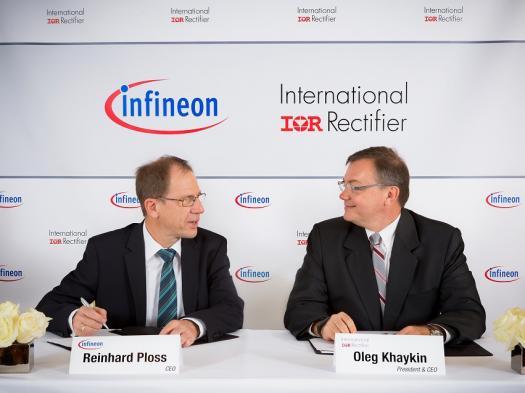Infineon and International Rectifier: what next?

What does Infineon's latest acquisition mean for industry? Compound Semiconductor talks to the company to find out its plans.
Infineon and International Rectifier: The deal is expected to close late this year or early next year
As the news sinks in that Infineon is to buy International Rectifier, many in the industry are wondering what next? In its biggest acquisition yet, Germany's largest chipmaker stumped up $3 billion in cash for IR, bolstering its international presence in the US and Asia, and gaining one of the largest manufacturers of power management chips in the world.
The move complement's Infineon's range of high voltage MOSFETs - the biggest chunk of IR revenue came from its low voltage MOSFETs - and also delivers low power IGBTs to its 1000 W to 2000 W range of the same devices. And while Infineon is still reaping the rewards of buying digital power management IC maker Primarion in 2008, IR provides power devices for new markets including notebooks and game consoles.
Still, the best may be yet to come. Infineon has been manufacturing SiC diodes since 2001, and introduced its first SiC transistor - the 'CoolSiC 1200V JFET - last year, which combined with MOSFET and driver IC gives a direct drive device for solar, UPS and industrial drives applications.
But while this has meant the business has had high voltage markets stitched up, the lower voltage end of the market has presented a problem. Not any more; enter IR with its GaN-on-silicon HEMTs for applications of 600 V and less.
"We started GaN research and development, but we haven't had a product on the market yet," says Tillmann Geneuss, manager of communications at Infineon. "It's no secret that for GaN companies such as International Rectifier and Transphorm are leading the competition."
Clearly, acquiring IR changes this. As Geneuss points out: "GaN has been a huge effort for IR, and it has generated a lot of intellectual property on the GaN-on-silicon epitaxy process."
Solid patents
And crucially the company has myriad very solid epitaxy-related patents for depositing the buffer and GaN layers onto the silicon substrate. "There is sapphire, silicon carbide and even bulk GaN, but silicon is the cheapest carrier solution," says Geneuss. "And that's why we think this has been a very valuable effort, because when it comes to the long-term and mass production, you have to look for the most cost-effective way to implement this."
Still Infineon isn't expecting instant gratification from IR's precious GaN-on-silicon technology. According to Geneuss, the market is in its infancy and GaN revenues have been very small for IR and other players such as Transphorm.
"We already are seeing first revenues but expect it will take five years or more before we see really significant revenues," he says.
In the interim the company is firmly focusing on developing 'the best solution' that will include IR's GaN-on-silicon devices and Infineon's SiC products. "Customers require solutions, not individual products, and these new materials will not survive as standalone products," he says. "So we want to include the new technology with, say, our best IGBT, MOSFET or diode, in the best package to offer the best solution in terms of cost-performance-ratio and power density."
So where does Infineon's plans leave other GaN-on-silicon companies? Japan multinational, Panasonic, holds a hefty chunk of the market's GaN-on-silicon IP and is sampling 600V GaN-on-silicon transistors. But what about the key, but much smaller players, such as Canada-based GaN Systems, EpiGaN, Belgium, Japan-based Transphorm and US-based EPC?
Media reports are already hinting at more acquisitions to come. And as senior analyst from Yole Développement, Philippe Roussel, told Compound Semiconductor: "We anticipate more consolidations in the GaN area over the next two years and have several indications to who might be the next ones, but cannot disclose."
And if the GaN-on-silicon market develops slowly, the industry's start-ups could falter. Just less than two years ago, US-based SiC device manufacturer, SemiSouth, closed down. Despite investment from Silicon Valley manufacturer of devices for high voltage power conversion systems, Power Integrations, the up and coming business clearly couldn't generate cash flow in a rising market. Could the same happen to pure GaN players?
As Geneuss concludes: "Introducing components on these emerging wide band-gap materials is a marathon, not a sprint."































